UGB 234: Entrepreneurship, Innovation & Creativity Management Report
VerifiedAdded on 2023/06/18
|12
|3718
|55
Report
AI Summary
This report delves into the management of entrepreneurship, innovation, and creativity, focusing on social entrepreneurship, motivations for its establishment, and its role in society. It highlights the importance of identifying market opportunities, creating employment, contributing to national income, and infrastructural development. The report includes a concept plan for a social enterprise named "The Rural Habitat," aimed at uplifting rural areas by providing financial assistance and affordable housing. The plan outlines objectives, market research strategies, target market, and marketing strategies, emphasizing the enterprise's commitment to social benefits over financial gains. This document is available on Desklib, a platform offering study tools and resources for students.
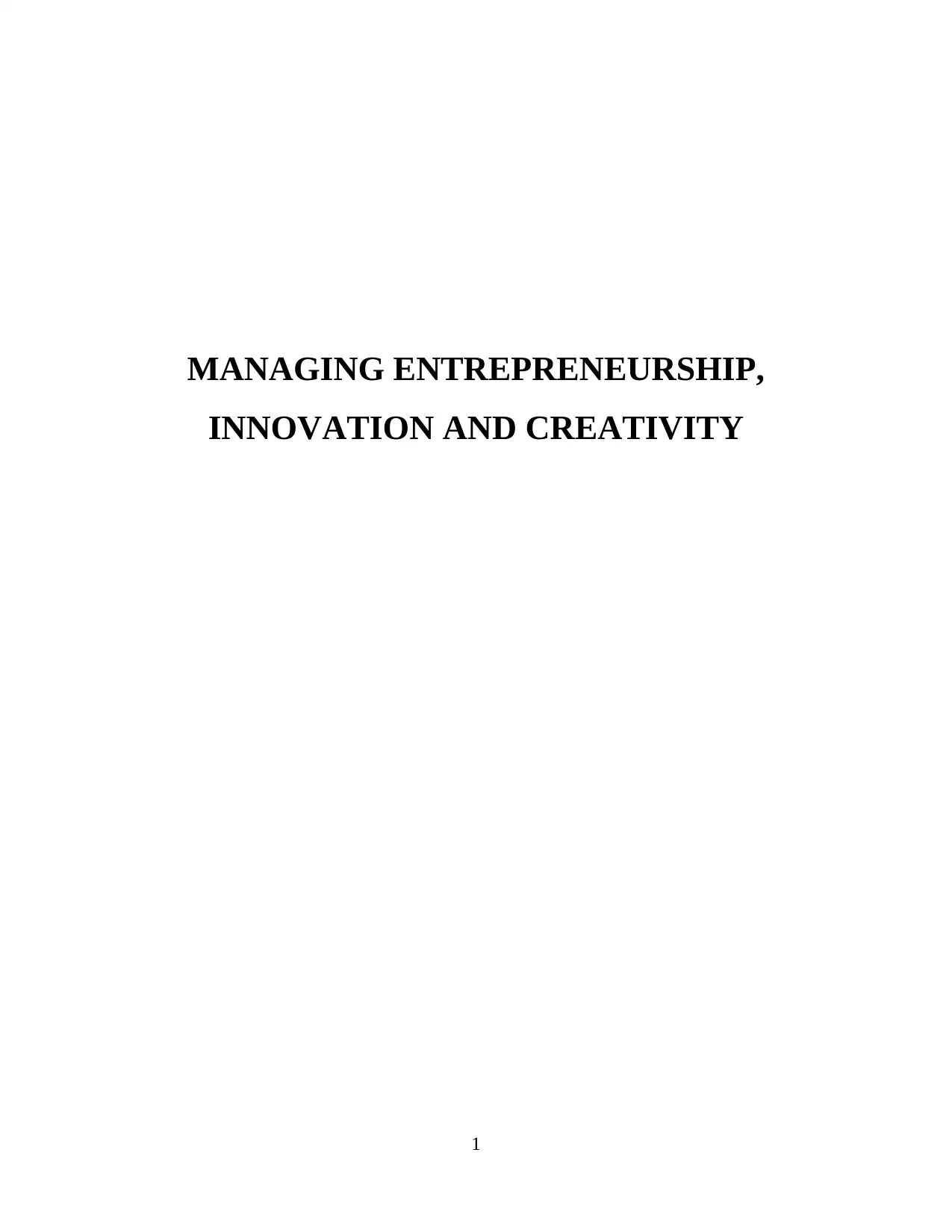
MANAGING ENTREPRENEURSHIP,
INNOVATION AND CREATIVITY
1
INNOVATION AND CREATIVITY
1
Paraphrase This Document
Need a fresh take? Get an instant paraphrase of this document with our AI Paraphraser
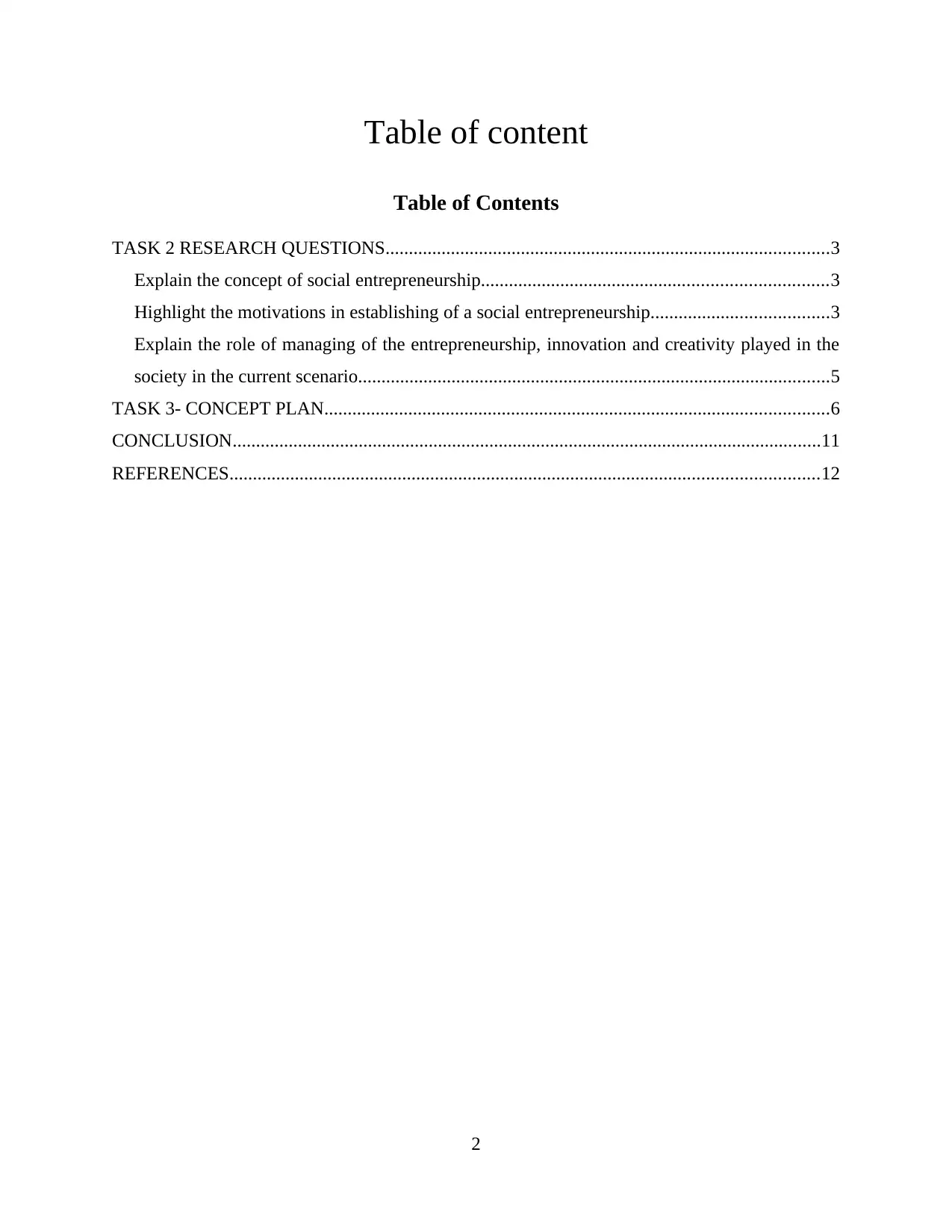
Table of content
Table of Contents
TASK 2 RESEARCH QUESTIONS...............................................................................................3
Explain the concept of social entrepreneurship..........................................................................3
Highlight the motivations in establishing of a social entrepreneurship......................................3
Explain the role of managing of the entrepreneurship, innovation and creativity played in the
society in the current scenario.....................................................................................................5
TASK 3- CONCEPT PLAN............................................................................................................6
CONCLUSION..............................................................................................................................11
REFERENCES..............................................................................................................................12
2
Table of Contents
TASK 2 RESEARCH QUESTIONS...............................................................................................3
Explain the concept of social entrepreneurship..........................................................................3
Highlight the motivations in establishing of a social entrepreneurship......................................3
Explain the role of managing of the entrepreneurship, innovation and creativity played in the
society in the current scenario.....................................................................................................5
TASK 3- CONCEPT PLAN............................................................................................................6
CONCLUSION..............................................................................................................................11
REFERENCES..............................................................................................................................12
2
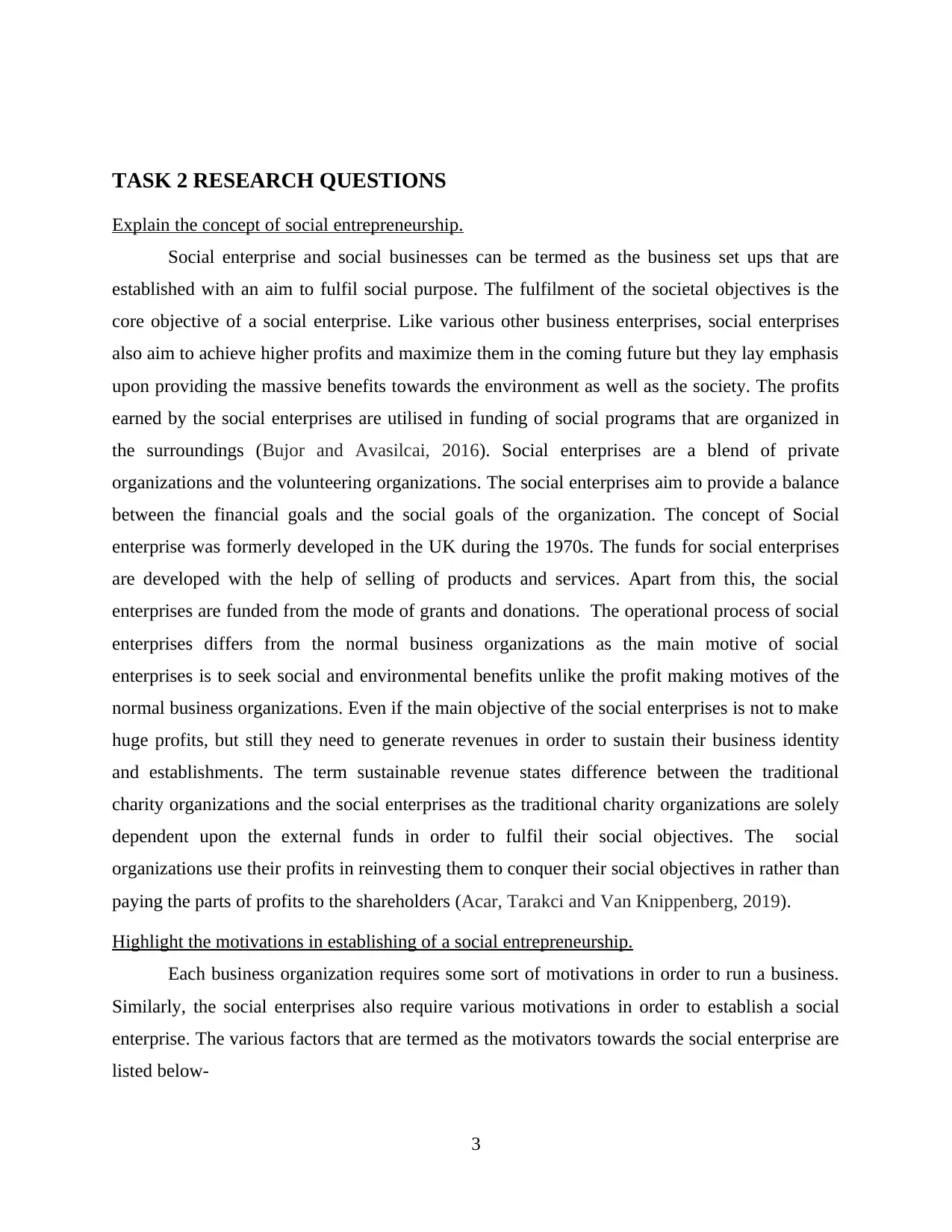
TASK 2 RESEARCH QUESTIONS
Explain the concept of social entrepreneurship.
Social enterprise and social businesses can be termed as the business set ups that are
established with an aim to fulfil social purpose. The fulfilment of the societal objectives is the
core objective of a social enterprise. Like various other business enterprises, social enterprises
also aim to achieve higher profits and maximize them in the coming future but they lay emphasis
upon providing the massive benefits towards the environment as well as the society. The profits
earned by the social enterprises are utilised in funding of social programs that are organized in
the surroundings (Bujor and Avasilcai, 2016). Social enterprises are a blend of private
organizations and the volunteering organizations. The social enterprises aim to provide a balance
between the financial goals and the social goals of the organization. The concept of Social
enterprise was formerly developed in the UK during the 1970s. The funds for social enterprises
are developed with the help of selling of products and services. Apart from this, the social
enterprises are funded from the mode of grants and donations. The operational process of social
enterprises differs from the normal business organizations as the main motive of social
enterprises is to seek social and environmental benefits unlike the profit making motives of the
normal business organizations. Even if the main objective of the social enterprises is not to make
huge profits, but still they need to generate revenues in order to sustain their business identity
and establishments. The term sustainable revenue states difference between the traditional
charity organizations and the social enterprises as the traditional charity organizations are solely
dependent upon the external funds in order to fulfil their social objectives. The social
organizations use their profits in reinvesting them to conquer their social objectives in rather than
paying the parts of profits to the shareholders (Acar, Tarakci and Van Knippenberg, 2019).
Highlight the motivations in establishing of a social entrepreneurship.
Each business organization requires some sort of motivations in order to run a business.
Similarly, the social enterprises also require various motivations in order to establish a social
enterprise. The various factors that are termed as the motivators towards the social enterprise are
listed below-
3
Explain the concept of social entrepreneurship.
Social enterprise and social businesses can be termed as the business set ups that are
established with an aim to fulfil social purpose. The fulfilment of the societal objectives is the
core objective of a social enterprise. Like various other business enterprises, social enterprises
also aim to achieve higher profits and maximize them in the coming future but they lay emphasis
upon providing the massive benefits towards the environment as well as the society. The profits
earned by the social enterprises are utilised in funding of social programs that are organized in
the surroundings (Bujor and Avasilcai, 2016). Social enterprises are a blend of private
organizations and the volunteering organizations. The social enterprises aim to provide a balance
between the financial goals and the social goals of the organization. The concept of Social
enterprise was formerly developed in the UK during the 1970s. The funds for social enterprises
are developed with the help of selling of products and services. Apart from this, the social
enterprises are funded from the mode of grants and donations. The operational process of social
enterprises differs from the normal business organizations as the main motive of social
enterprises is to seek social and environmental benefits unlike the profit making motives of the
normal business organizations. Even if the main objective of the social enterprises is not to make
huge profits, but still they need to generate revenues in order to sustain their business identity
and establishments. The term sustainable revenue states difference between the traditional
charity organizations and the social enterprises as the traditional charity organizations are solely
dependent upon the external funds in order to fulfil their social objectives. The social
organizations use their profits in reinvesting them to conquer their social objectives in rather than
paying the parts of profits to the shareholders (Acar, Tarakci and Van Knippenberg, 2019).
Highlight the motivations in establishing of a social entrepreneurship.
Each business organization requires some sort of motivations in order to run a business.
Similarly, the social enterprises also require various motivations in order to establish a social
enterprise. The various factors that are termed as the motivators towards the social enterprise are
listed below-
3
⊘ This is a preview!⊘
Do you want full access?
Subscribe today to unlock all pages.

Trusted by 1+ million students worldwide
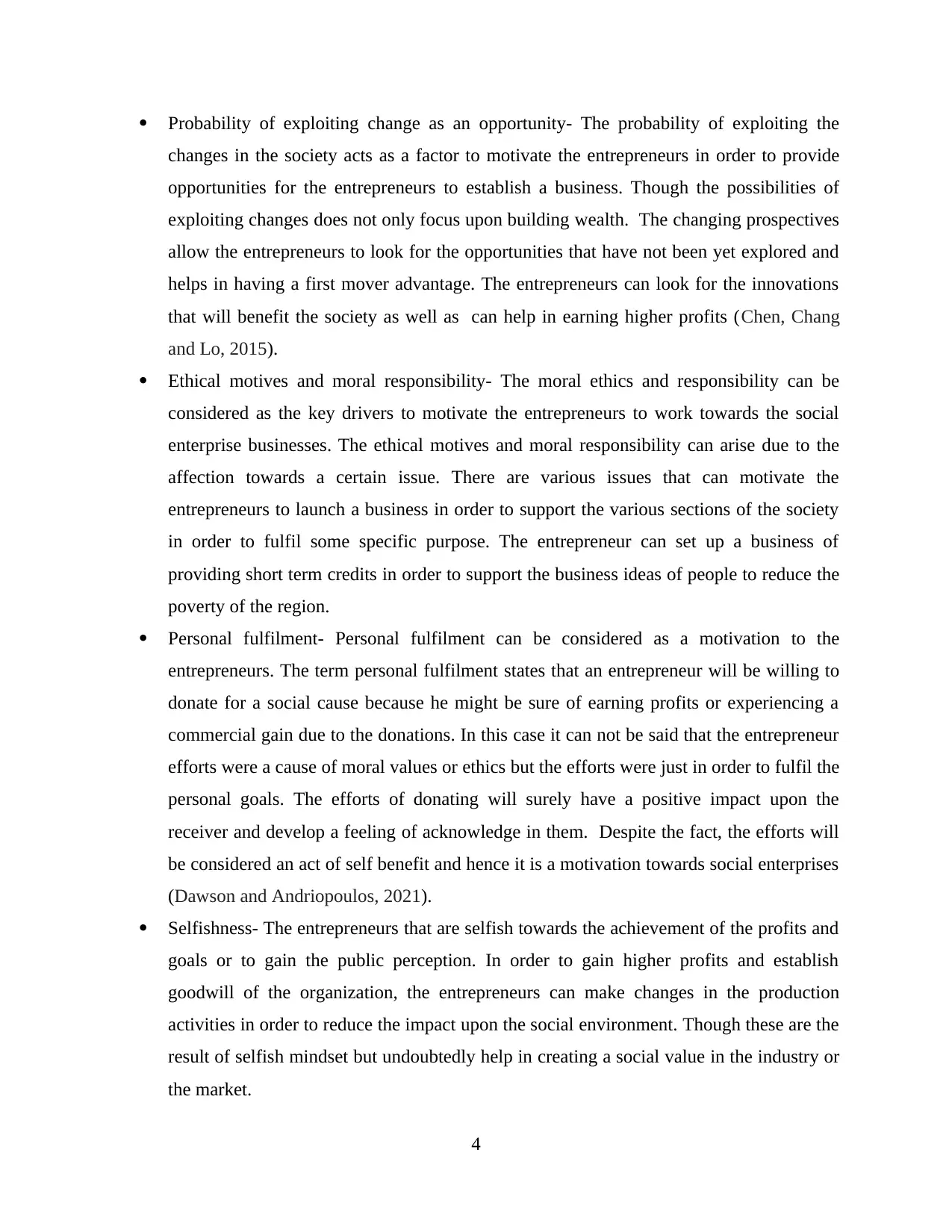
Probability of exploiting change as an opportunity- The probability of exploiting the
changes in the society acts as a factor to motivate the entrepreneurs in order to provide
opportunities for the entrepreneurs to establish a business. Though the possibilities of
exploiting changes does not only focus upon building wealth. The changing prospectives
allow the entrepreneurs to look for the opportunities that have not been yet explored and
helps in having a first mover advantage. The entrepreneurs can look for the innovations
that will benefit the society as well as can help in earning higher profits (Chen, Chang
and Lo, 2015).
Ethical motives and moral responsibility- The moral ethics and responsibility can be
considered as the key drivers to motivate the entrepreneurs to work towards the social
enterprise businesses. The ethical motives and moral responsibility can arise due to the
affection towards a certain issue. There are various issues that can motivate the
entrepreneurs to launch a business in order to support the various sections of the society
in order to fulfil some specific purpose. The entrepreneur can set up a business of
providing short term credits in order to support the business ideas of people to reduce the
poverty of the region.
Personal fulfilment- Personal fulfilment can be considered as a motivation to the
entrepreneurs. The term personal fulfilment states that an entrepreneur will be willing to
donate for a social cause because he might be sure of earning profits or experiencing a
commercial gain due to the donations. In this case it can not be said that the entrepreneur
efforts were a cause of moral values or ethics but the efforts were just in order to fulfil the
personal goals. The efforts of donating will surely have a positive impact upon the
receiver and develop a feeling of acknowledge in them. Despite the fact, the efforts will
be considered an act of self benefit and hence it is a motivation towards social enterprises
(Dawson and Andriopoulos, 2021).
Selfishness- The entrepreneurs that are selfish towards the achievement of the profits and
goals or to gain the public perception. In order to gain higher profits and establish
goodwill of the organization, the entrepreneurs can make changes in the production
activities in order to reduce the impact upon the social environment. Though these are the
result of selfish mindset but undoubtedly help in creating a social value in the industry or
the market.
4
changes in the society acts as a factor to motivate the entrepreneurs in order to provide
opportunities for the entrepreneurs to establish a business. Though the possibilities of
exploiting changes does not only focus upon building wealth. The changing prospectives
allow the entrepreneurs to look for the opportunities that have not been yet explored and
helps in having a first mover advantage. The entrepreneurs can look for the innovations
that will benefit the society as well as can help in earning higher profits (Chen, Chang
and Lo, 2015).
Ethical motives and moral responsibility- The moral ethics and responsibility can be
considered as the key drivers to motivate the entrepreneurs to work towards the social
enterprise businesses. The ethical motives and moral responsibility can arise due to the
affection towards a certain issue. There are various issues that can motivate the
entrepreneurs to launch a business in order to support the various sections of the society
in order to fulfil some specific purpose. The entrepreneur can set up a business of
providing short term credits in order to support the business ideas of people to reduce the
poverty of the region.
Personal fulfilment- Personal fulfilment can be considered as a motivation to the
entrepreneurs. The term personal fulfilment states that an entrepreneur will be willing to
donate for a social cause because he might be sure of earning profits or experiencing a
commercial gain due to the donations. In this case it can not be said that the entrepreneur
efforts were a cause of moral values or ethics but the efforts were just in order to fulfil the
personal goals. The efforts of donating will surely have a positive impact upon the
receiver and develop a feeling of acknowledge in them. Despite the fact, the efforts will
be considered an act of self benefit and hence it is a motivation towards social enterprises
(Dawson and Andriopoulos, 2021).
Selfishness- The entrepreneurs that are selfish towards the achievement of the profits and
goals or to gain the public perception. In order to gain higher profits and establish
goodwill of the organization, the entrepreneurs can make changes in the production
activities in order to reduce the impact upon the social environment. Though these are the
result of selfish mindset but undoubtedly help in creating a social value in the industry or
the market.
4
Paraphrase This Document
Need a fresh take? Get an instant paraphrase of this document with our AI Paraphraser

Explain the role of managing of the entrepreneurship, innovation and creativity played in the
society in the current scenario.
The entrepreneurship, innovation and creativity have an important role to play in the society as
per the current scenario. The roles of managing the entrepreneurship, innovation and creativity
are explained below in detail.
The role played by entrepreneurship in society
Identifying the opportunities in the market- The production of goods and services allow
the entrepreneurial businesses to satisfy the needs of the customers. The researches
conducted in the market allow the organization to identify the various needs and
requirements of the customers that can arise with the course of time. The opportunity to
explore the business opportunity allows the organization to expand the business as per the
need of the market (Dogan, 2015).
Creation of employment opportunities- The entrepreneurial activities allow the
organization to create various opportunities in order to increase employment level in the
society. The entrepreneurial activities allow the enterprises to generate the higher number
of employed workforce in the organization. It helps in bridging up the unemployment gap
in a society.
Contributes to the national income- The business ventures allow the organizations to
generate revenue and thus needs to pay taxes that contribute towards the development of
the society. The ventures further contribute towards the national income and GDP of the
region.
Infrastructural development- The ventures contribute towards the development of
infrastructure in the society. Whenever a business is established, it generates a need of
transportation and communication facilities in that area. Hence in order to accommodate
the businesses, the needs of the organization are fulfilled. Hence entrepreneurship has a
huge role to play in the development of infrastructure upon the society (Edwards-
Schachter and et,al., 2015).
Role of innovation and creativity
Enhances business reputation- In today's scenario there are various organizations that
produce same products and services and hence innovation practices allow the
5
society in the current scenario.
The entrepreneurship, innovation and creativity have an important role to play in the society as
per the current scenario. The roles of managing the entrepreneurship, innovation and creativity
are explained below in detail.
The role played by entrepreneurship in society
Identifying the opportunities in the market- The production of goods and services allow
the entrepreneurial businesses to satisfy the needs of the customers. The researches
conducted in the market allow the organization to identify the various needs and
requirements of the customers that can arise with the course of time. The opportunity to
explore the business opportunity allows the organization to expand the business as per the
need of the market (Dogan, 2015).
Creation of employment opportunities- The entrepreneurial activities allow the
organization to create various opportunities in order to increase employment level in the
society. The entrepreneurial activities allow the enterprises to generate the higher number
of employed workforce in the organization. It helps in bridging up the unemployment gap
in a society.
Contributes to the national income- The business ventures allow the organizations to
generate revenue and thus needs to pay taxes that contribute towards the development of
the society. The ventures further contribute towards the national income and GDP of the
region.
Infrastructural development- The ventures contribute towards the development of
infrastructure in the society. Whenever a business is established, it generates a need of
transportation and communication facilities in that area. Hence in order to accommodate
the businesses, the needs of the organization are fulfilled. Hence entrepreneurship has a
huge role to play in the development of infrastructure upon the society (Edwards-
Schachter and et,al., 2015).
Role of innovation and creativity
Enhances business reputation- In today's scenario there are various organizations that
produce same products and services and hence innovation practices allow the
5
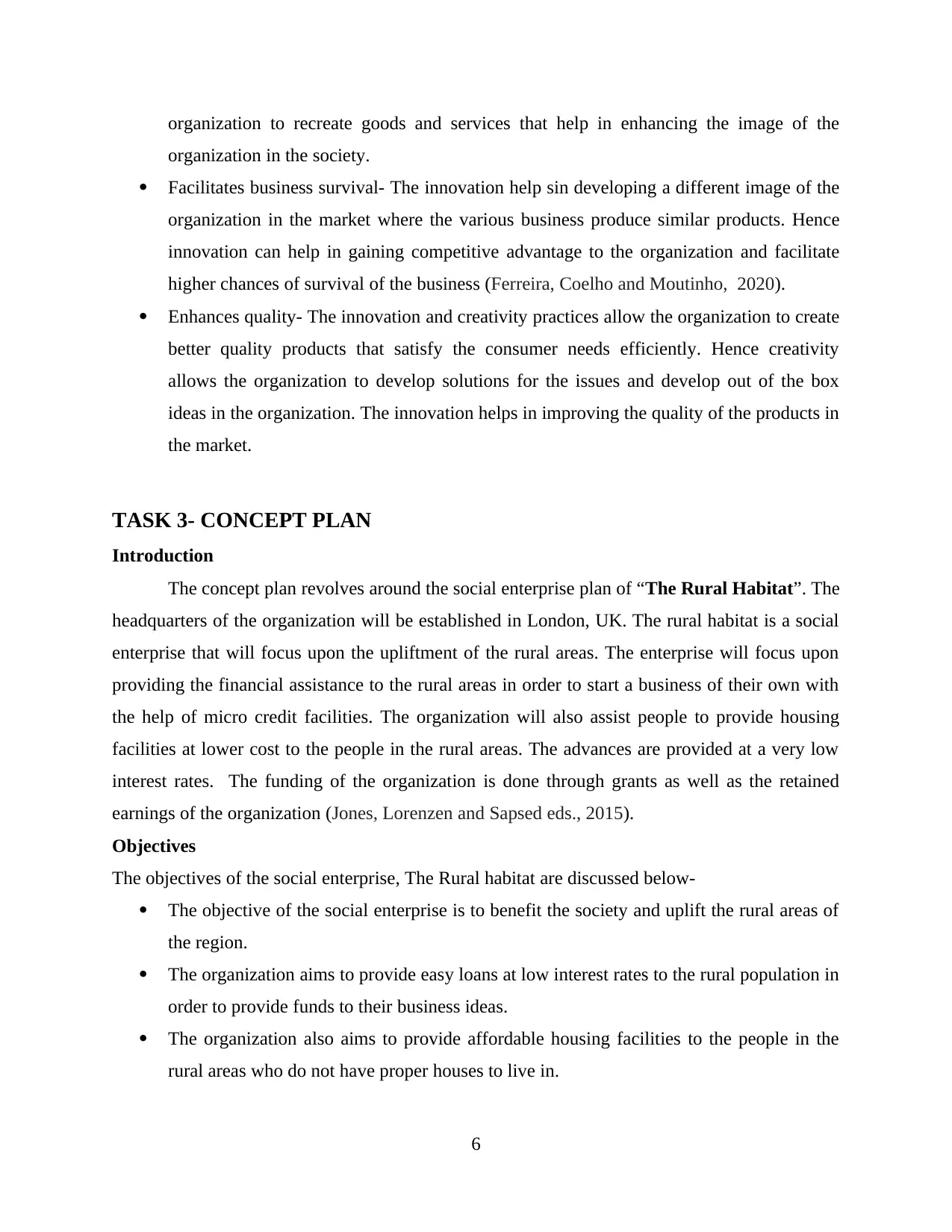
organization to recreate goods and services that help in enhancing the image of the
organization in the society.
Facilitates business survival- The innovation help sin developing a different image of the
organization in the market where the various business produce similar products. Hence
innovation can help in gaining competitive advantage to the organization and facilitate
higher chances of survival of the business (Ferreira, Coelho and Moutinho, 2020).
Enhances quality- The innovation and creativity practices allow the organization to create
better quality products that satisfy the consumer needs efficiently. Hence creativity
allows the organization to develop solutions for the issues and develop out of the box
ideas in the organization. The innovation helps in improving the quality of the products in
the market.
TASK 3- CONCEPT PLAN
Introduction
The concept plan revolves around the social enterprise plan of “The Rural Habitat”. The
headquarters of the organization will be established in London, UK. The rural habitat is a social
enterprise that will focus upon the upliftment of the rural areas. The enterprise will focus upon
providing the financial assistance to the rural areas in order to start a business of their own with
the help of micro credit facilities. The organization will also assist people to provide housing
facilities at lower cost to the people in the rural areas. The advances are provided at a very low
interest rates. The funding of the organization is done through grants as well as the retained
earnings of the organization (Jones, Lorenzen and Sapsed eds., 2015).
Objectives
The objectives of the social enterprise, The Rural habitat are discussed below-
The objective of the social enterprise is to benefit the society and uplift the rural areas of
the region.
The organization aims to provide easy loans at low interest rates to the rural population in
order to provide funds to their business ideas.
The organization also aims to provide affordable housing facilities to the people in the
rural areas who do not have proper houses to live in.
6
organization in the society.
Facilitates business survival- The innovation help sin developing a different image of the
organization in the market where the various business produce similar products. Hence
innovation can help in gaining competitive advantage to the organization and facilitate
higher chances of survival of the business (Ferreira, Coelho and Moutinho, 2020).
Enhances quality- The innovation and creativity practices allow the organization to create
better quality products that satisfy the consumer needs efficiently. Hence creativity
allows the organization to develop solutions for the issues and develop out of the box
ideas in the organization. The innovation helps in improving the quality of the products in
the market.
TASK 3- CONCEPT PLAN
Introduction
The concept plan revolves around the social enterprise plan of “The Rural Habitat”. The
headquarters of the organization will be established in London, UK. The rural habitat is a social
enterprise that will focus upon the upliftment of the rural areas. The enterprise will focus upon
providing the financial assistance to the rural areas in order to start a business of their own with
the help of micro credit facilities. The organization will also assist people to provide housing
facilities at lower cost to the people in the rural areas. The advances are provided at a very low
interest rates. The funding of the organization is done through grants as well as the retained
earnings of the organization (Jones, Lorenzen and Sapsed eds., 2015).
Objectives
The objectives of the social enterprise, The Rural habitat are discussed below-
The objective of the social enterprise is to benefit the society and uplift the rural areas of
the region.
The organization aims to provide easy loans at low interest rates to the rural population in
order to provide funds to their business ideas.
The organization also aims to provide affordable housing facilities to the people in the
rural areas who do not have proper houses to live in.
6
⊘ This is a preview!⊘
Do you want full access?
Subscribe today to unlock all pages.

Trusted by 1+ million students worldwide
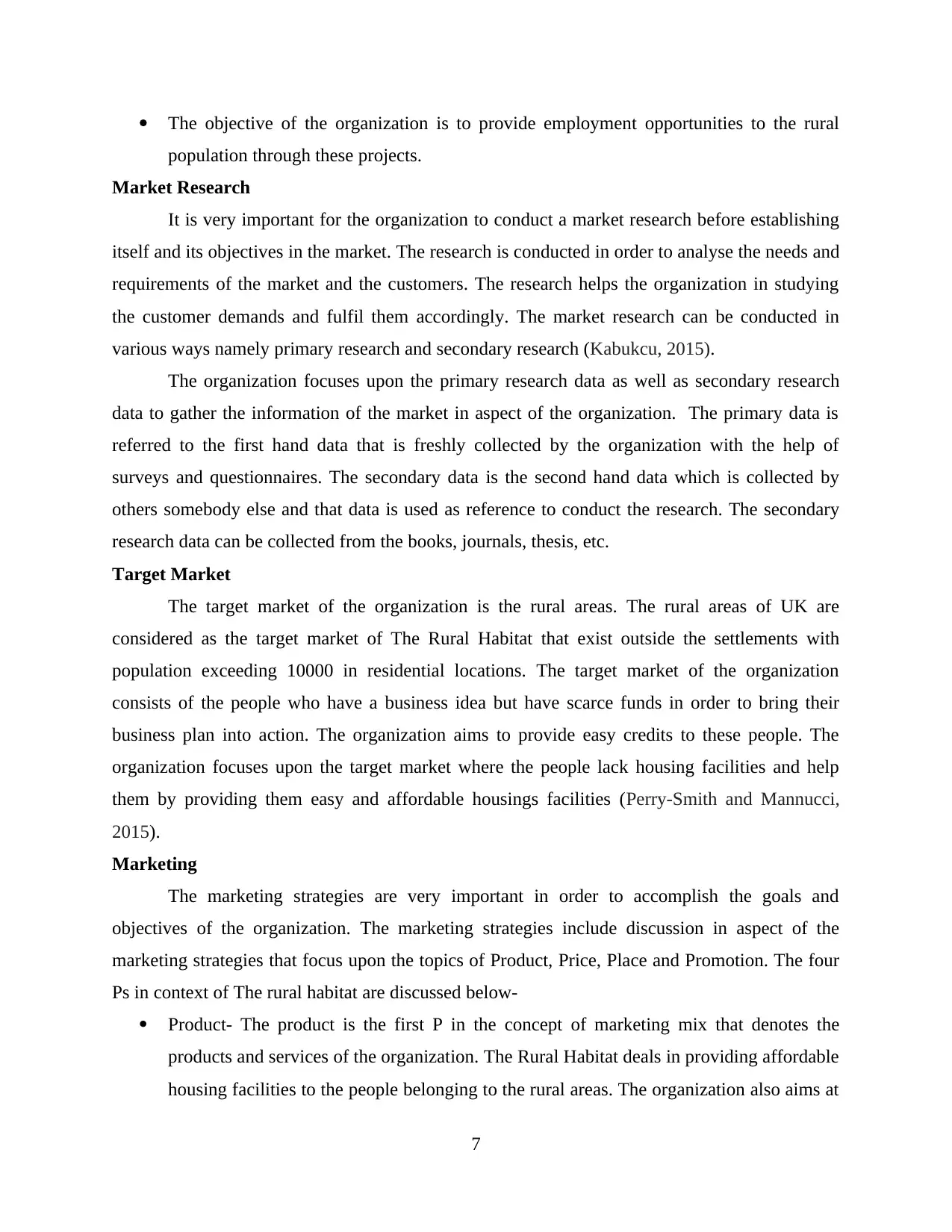
The objective of the organization is to provide employment opportunities to the rural
population through these projects.
Market Research
It is very important for the organization to conduct a market research before establishing
itself and its objectives in the market. The research is conducted in order to analyse the needs and
requirements of the market and the customers. The research helps the organization in studying
the customer demands and fulfil them accordingly. The market research can be conducted in
various ways namely primary research and secondary research (Kabukcu, 2015).
The organization focuses upon the primary research data as well as secondary research
data to gather the information of the market in aspect of the organization. The primary data is
referred to the first hand data that is freshly collected by the organization with the help of
surveys and questionnaires. The secondary data is the second hand data which is collected by
others somebody else and that data is used as reference to conduct the research. The secondary
research data can be collected from the books, journals, thesis, etc.
Target Market
The target market of the organization is the rural areas. The rural areas of UK are
considered as the target market of The Rural Habitat that exist outside the settlements with
population exceeding 10000 in residential locations. The target market of the organization
consists of the people who have a business idea but have scarce funds in order to bring their
business plan into action. The organization aims to provide easy credits to these people. The
organization focuses upon the target market where the people lack housing facilities and help
them by providing them easy and affordable housings facilities (Perry-Smith and Mannucci,
2015).
Marketing
The marketing strategies are very important in order to accomplish the goals and
objectives of the organization. The marketing strategies include discussion in aspect of the
marketing strategies that focus upon the topics of Product, Price, Place and Promotion. The four
Ps in context of The rural habitat are discussed below-
Product- The product is the first P in the concept of marketing mix that denotes the
products and services of the organization. The Rural Habitat deals in providing affordable
housing facilities to the people belonging to the rural areas. The organization also aims at
7
population through these projects.
Market Research
It is very important for the organization to conduct a market research before establishing
itself and its objectives in the market. The research is conducted in order to analyse the needs and
requirements of the market and the customers. The research helps the organization in studying
the customer demands and fulfil them accordingly. The market research can be conducted in
various ways namely primary research and secondary research (Kabukcu, 2015).
The organization focuses upon the primary research data as well as secondary research
data to gather the information of the market in aspect of the organization. The primary data is
referred to the first hand data that is freshly collected by the organization with the help of
surveys and questionnaires. The secondary data is the second hand data which is collected by
others somebody else and that data is used as reference to conduct the research. The secondary
research data can be collected from the books, journals, thesis, etc.
Target Market
The target market of the organization is the rural areas. The rural areas of UK are
considered as the target market of The Rural Habitat that exist outside the settlements with
population exceeding 10000 in residential locations. The target market of the organization
consists of the people who have a business idea but have scarce funds in order to bring their
business plan into action. The organization aims to provide easy credits to these people. The
organization focuses upon the target market where the people lack housing facilities and help
them by providing them easy and affordable housings facilities (Perry-Smith and Mannucci,
2015).
Marketing
The marketing strategies are very important in order to accomplish the goals and
objectives of the organization. The marketing strategies include discussion in aspect of the
marketing strategies that focus upon the topics of Product, Price, Place and Promotion. The four
Ps in context of The rural habitat are discussed below-
Product- The product is the first P in the concept of marketing mix that denotes the
products and services of the organization. The Rural Habitat deals in providing affordable
housing facilities to the people belonging to the rural areas. The organization also aims at
7
Paraphrase This Document
Need a fresh take? Get an instant paraphrase of this document with our AI Paraphraser
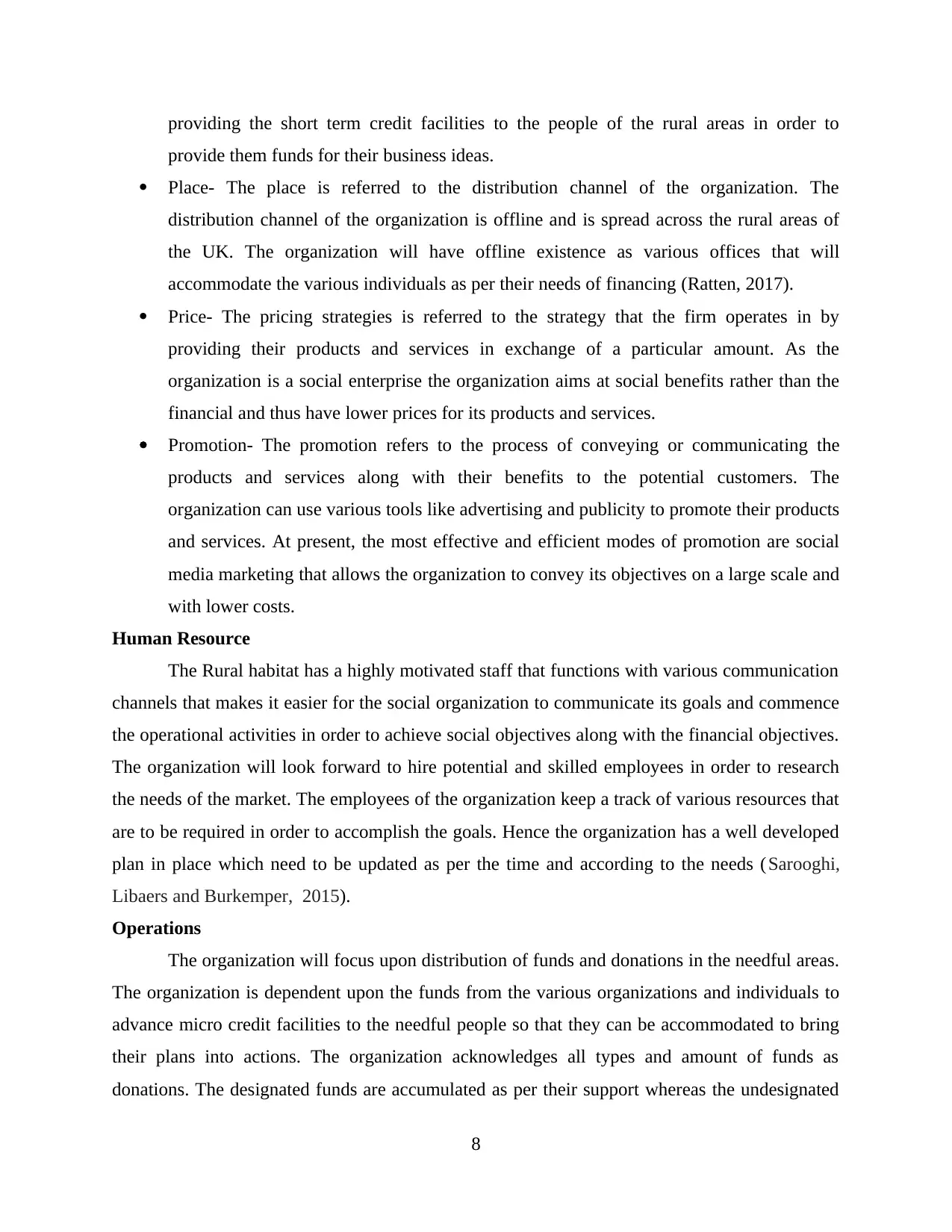
providing the short term credit facilities to the people of the rural areas in order to
provide them funds for their business ideas.
Place- The place is referred to the distribution channel of the organization. The
distribution channel of the organization is offline and is spread across the rural areas of
the UK. The organization will have offline existence as various offices that will
accommodate the various individuals as per their needs of financing (Ratten, 2017).
Price- The pricing strategies is referred to the strategy that the firm operates in by
providing their products and services in exchange of a particular amount. As the
organization is a social enterprise the organization aims at social benefits rather than the
financial and thus have lower prices for its products and services.
Promotion- The promotion refers to the process of conveying or communicating the
products and services along with their benefits to the potential customers. The
organization can use various tools like advertising and publicity to promote their products
and services. At present, the most effective and efficient modes of promotion are social
media marketing that allows the organization to convey its objectives on a large scale and
with lower costs.
Human Resource
The Rural habitat has a highly motivated staff that functions with various communication
channels that makes it easier for the social organization to communicate its goals and commence
the operational activities in order to achieve social objectives along with the financial objectives.
The organization will look forward to hire potential and skilled employees in order to research
the needs of the market. The employees of the organization keep a track of various resources that
are to be required in order to accomplish the goals. Hence the organization has a well developed
plan in place which need to be updated as per the time and according to the needs (Sarooghi,
Libaers and Burkemper, 2015).
Operations
The organization will focus upon distribution of funds and donations in the needful areas.
The organization is dependent upon the funds from the various organizations and individuals to
advance micro credit facilities to the needful people so that they can be accommodated to bring
their plans into actions. The organization acknowledges all types and amount of funds as
donations. The designated funds are accumulated as per their support whereas the undesignated
8
provide them funds for their business ideas.
Place- The place is referred to the distribution channel of the organization. The
distribution channel of the organization is offline and is spread across the rural areas of
the UK. The organization will have offline existence as various offices that will
accommodate the various individuals as per their needs of financing (Ratten, 2017).
Price- The pricing strategies is referred to the strategy that the firm operates in by
providing their products and services in exchange of a particular amount. As the
organization is a social enterprise the organization aims at social benefits rather than the
financial and thus have lower prices for its products and services.
Promotion- The promotion refers to the process of conveying or communicating the
products and services along with their benefits to the potential customers. The
organization can use various tools like advertising and publicity to promote their products
and services. At present, the most effective and efficient modes of promotion are social
media marketing that allows the organization to convey its objectives on a large scale and
with lower costs.
Human Resource
The Rural habitat has a highly motivated staff that functions with various communication
channels that makes it easier for the social organization to communicate its goals and commence
the operational activities in order to achieve social objectives along with the financial objectives.
The organization will look forward to hire potential and skilled employees in order to research
the needs of the market. The employees of the organization keep a track of various resources that
are to be required in order to accomplish the goals. Hence the organization has a well developed
plan in place which need to be updated as per the time and according to the needs (Sarooghi,
Libaers and Burkemper, 2015).
Operations
The organization will focus upon distribution of funds and donations in the needful areas.
The organization is dependent upon the funds from the various organizations and individuals to
advance micro credit facilities to the needful people so that they can be accommodated to bring
their plans into actions. The organization acknowledges all types and amount of funds as
donations. The designated funds are accumulated as per their support whereas the undesignated
8

donations are invested as per the need of the hour and tend to have a better impact. The funds of
the organization are used for the various operational purposes. These purposes are discussed
below-
These funds help in designing and replicating the innovative programs that are planned
in order to serve the lower income groups of the society.
These funds help in building capacity of the organization's network in the UK.
These funds can help in compensating the various other costs of the organization in order
to compensate the losses (Sutanto, 2017).
The organizational structure of the Rural Habitat will consist of board of directors that
will monitor and control the operations of the organization. The headquarters of the organization
will be operated by administration staff, volunteers and the professional and support employees.
Legal issues
There are various legal issues that can be faced by the social enterprise. The most
common legal issues faced by the organizations are the issue related to the legal status of the
organization and regulatory issues.
Business structure- The organization has various legal statuses to choose from, such as
sole proprietorship, partnership, corporations, etc. The most trusted and effective mode of
business structure for the social enterprise is to get it registered as a limited company.
The reason behind this is, the limited company has a separated legal identity and thus it
helps the organization to have a wider reach.
Regulatory approval- It is crucial for the various social enterprises to have a legal
approval from the government in order to deal with the social issues of the society and
environment. It is suggested for the organization to hire a professional lawyer who can
guide the path to the organization regarding the various approvals that are required in
order to function as a social enterprise for various social issues (Tülüce and Yurtkur,
2015).
Financial
The financial plan of the “The rural habitat” is discussed below-
9
the organization are used for the various operational purposes. These purposes are discussed
below-
These funds help in designing and replicating the innovative programs that are planned
in order to serve the lower income groups of the society.
These funds help in building capacity of the organization's network in the UK.
These funds can help in compensating the various other costs of the organization in order
to compensate the losses (Sutanto, 2017).
The organizational structure of the Rural Habitat will consist of board of directors that
will monitor and control the operations of the organization. The headquarters of the organization
will be operated by administration staff, volunteers and the professional and support employees.
Legal issues
There are various legal issues that can be faced by the social enterprise. The most
common legal issues faced by the organizations are the issue related to the legal status of the
organization and regulatory issues.
Business structure- The organization has various legal statuses to choose from, such as
sole proprietorship, partnership, corporations, etc. The most trusted and effective mode of
business structure for the social enterprise is to get it registered as a limited company.
The reason behind this is, the limited company has a separated legal identity and thus it
helps the organization to have a wider reach.
Regulatory approval- It is crucial for the various social enterprises to have a legal
approval from the government in order to deal with the social issues of the society and
environment. It is suggested for the organization to hire a professional lawyer who can
guide the path to the organization regarding the various approvals that are required in
order to function as a social enterprise for various social issues (Tülüce and Yurtkur,
2015).
Financial
The financial plan of the “The rural habitat” is discussed below-
9
⊘ This is a preview!⊘
Do you want full access?
Subscribe today to unlock all pages.

Trusted by 1+ million students worldwide

Expenditures Cost
Human resource £ 10000
Operations £ 15500
Marketing £ 8000
£ 33500
Risk and contingency
The social enterprises are prone to the risks in the operational activity of the organization.
The various risks are discussed below-
Physical risks- The physical risk can occur due to the disruption or missing of any
confidential or useful information or tools. The disruption may be caused due to the
occurrence of natural disasters or any unfortunate circumstances.
Technical issues- Technical issues also comprise of various risk factors and can lead to
contingencies. The technical issues can be caused due to the failure in the system that can
disrupt the technical functioning in the organization. It might lead to delay in the
operational tasks (Zhou, 2015).
Exit strategies
There are various exit strategies that can be used by the investor in order to get the return
on investment. The exit strategies are crucial to discuss as they shape the path for strategic
decisions in future. There are various kinds of exit strategies that the organization can choose
from. The various exit strategies are discussed below-
Acquisitions- Acquisition is referred to the takeover of a business organization by
another organization. The assets need to be in a liquid state or else the acquisition is not
considered as exit. There are two types of acquisitions namely strategic acquisition and
sectoral merger. The strategic acquisition is referred to the acquisition when the acquiring
organization belongs to different industry where as merger is referred to the acquisition
of the organizations within the same industry.
Secondary sales- the process of exit is when the existing shares are sold in the equity
market to the secondary investors.
10
Human resource £ 10000
Operations £ 15500
Marketing £ 8000
£ 33500
Risk and contingency
The social enterprises are prone to the risks in the operational activity of the organization.
The various risks are discussed below-
Physical risks- The physical risk can occur due to the disruption or missing of any
confidential or useful information or tools. The disruption may be caused due to the
occurrence of natural disasters or any unfortunate circumstances.
Technical issues- Technical issues also comprise of various risk factors and can lead to
contingencies. The technical issues can be caused due to the failure in the system that can
disrupt the technical functioning in the organization. It might lead to delay in the
operational tasks (Zhou, 2015).
Exit strategies
There are various exit strategies that can be used by the investor in order to get the return
on investment. The exit strategies are crucial to discuss as they shape the path for strategic
decisions in future. There are various kinds of exit strategies that the organization can choose
from. The various exit strategies are discussed below-
Acquisitions- Acquisition is referred to the takeover of a business organization by
another organization. The assets need to be in a liquid state or else the acquisition is not
considered as exit. There are two types of acquisitions namely strategic acquisition and
sectoral merger. The strategic acquisition is referred to the acquisition when the acquiring
organization belongs to different industry where as merger is referred to the acquisition
of the organizations within the same industry.
Secondary sales- the process of exit is when the existing shares are sold in the equity
market to the secondary investors.
10
Paraphrase This Document
Need a fresh take? Get an instant paraphrase of this document with our AI Paraphraser
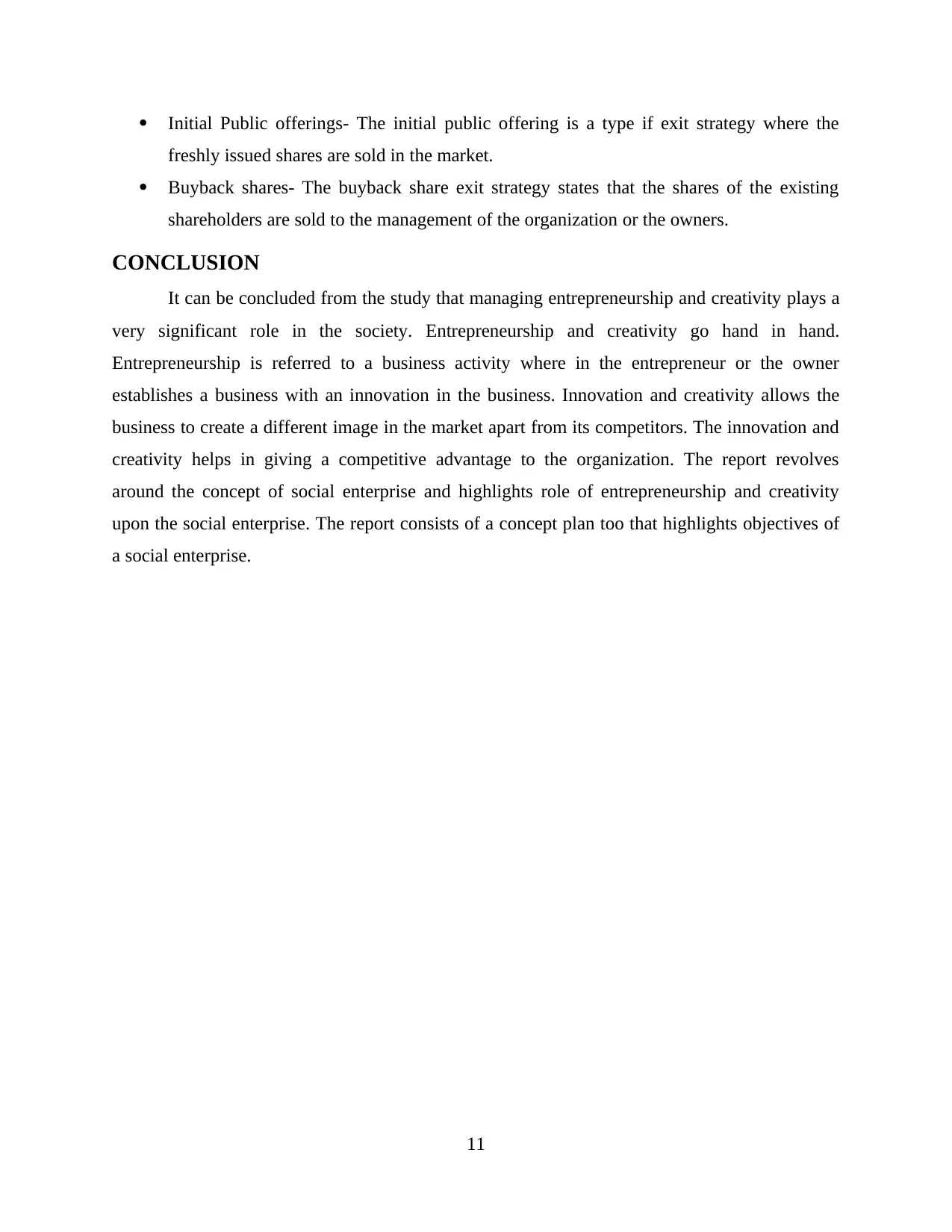
Initial Public offerings- The initial public offering is a type if exit strategy where the
freshly issued shares are sold in the market.
Buyback shares- The buyback share exit strategy states that the shares of the existing
shareholders are sold to the management of the organization or the owners.
CONCLUSION
It can be concluded from the study that managing entrepreneurship and creativity plays a
very significant role in the society. Entrepreneurship and creativity go hand in hand.
Entrepreneurship is referred to a business activity where in the entrepreneur or the owner
establishes a business with an innovation in the business. Innovation and creativity allows the
business to create a different image in the market apart from its competitors. The innovation and
creativity helps in giving a competitive advantage to the organization. The report revolves
around the concept of social enterprise and highlights role of entrepreneurship and creativity
upon the social enterprise. The report consists of a concept plan too that highlights objectives of
a social enterprise.
11
freshly issued shares are sold in the market.
Buyback shares- The buyback share exit strategy states that the shares of the existing
shareholders are sold to the management of the organization or the owners.
CONCLUSION
It can be concluded from the study that managing entrepreneurship and creativity plays a
very significant role in the society. Entrepreneurship and creativity go hand in hand.
Entrepreneurship is referred to a business activity where in the entrepreneur or the owner
establishes a business with an innovation in the business. Innovation and creativity allows the
business to create a different image in the market apart from its competitors. The innovation and
creativity helps in giving a competitive advantage to the organization. The report revolves
around the concept of social enterprise and highlights role of entrepreneurship and creativity
upon the social enterprise. The report consists of a concept plan too that highlights objectives of
a social enterprise.
11
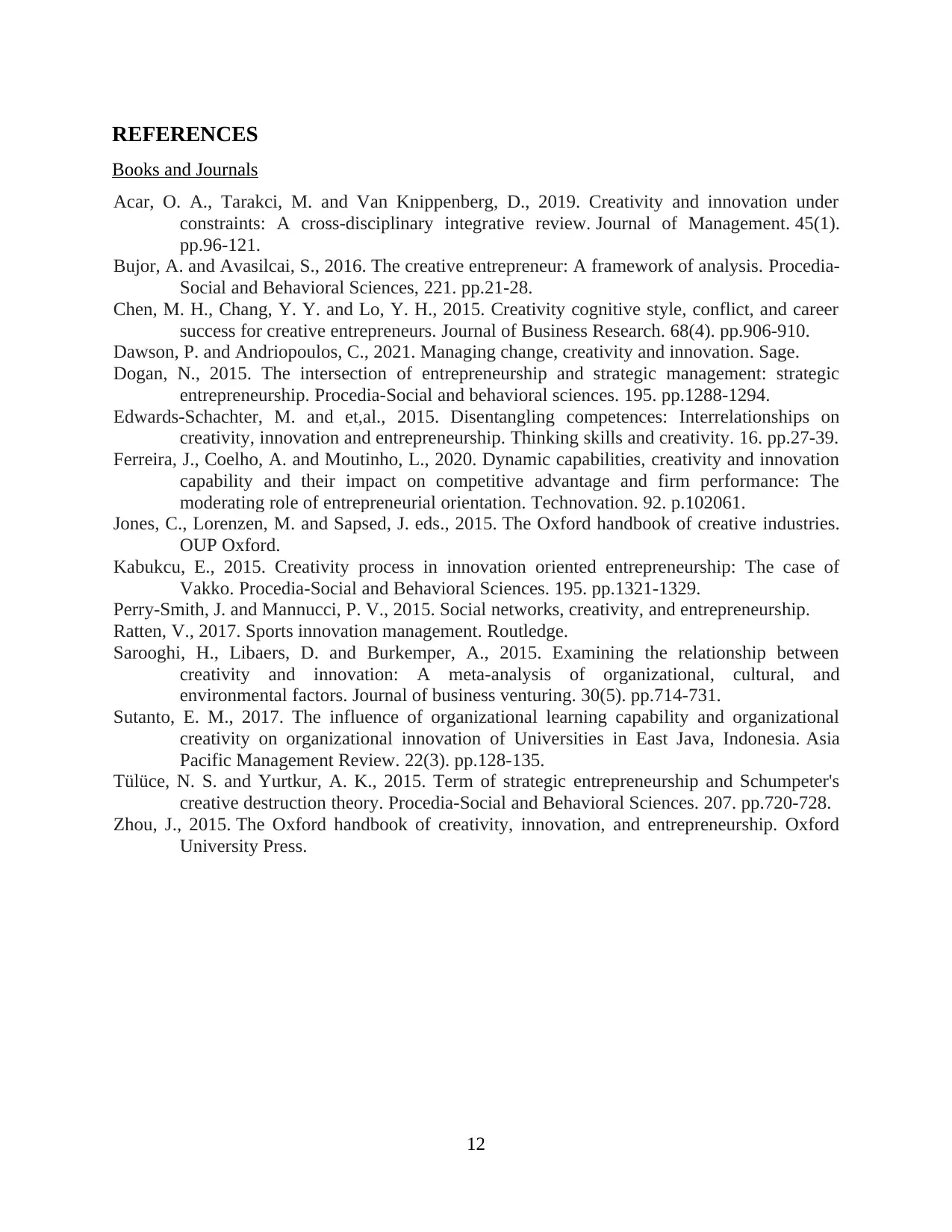
REFERENCES
Books and Journals
Acar, O. A., Tarakci, M. and Van Knippenberg, D., 2019. Creativity and innovation under
constraints: A cross-disciplinary integrative review. Journal of Management. 45(1).
pp.96-121.
Bujor, A. and Avasilcai, S., 2016. The creative entrepreneur: A framework of analysis. Procedia-
Social and Behavioral Sciences, 221. pp.21-28.
Chen, M. H., Chang, Y. Y. and Lo, Y. H., 2015. Creativity cognitive style, conflict, and career
success for creative entrepreneurs. Journal of Business Research. 68(4). pp.906-910.
Dawson, P. and Andriopoulos, C., 2021. Managing change, creativity and innovation. Sage.
Dogan, N., 2015. The intersection of entrepreneurship and strategic management: strategic
entrepreneurship. Procedia-Social and behavioral sciences. 195. pp.1288-1294.
Edwards-Schachter, M. and et,al., 2015. Disentangling competences: Interrelationships on
creativity, innovation and entrepreneurship. Thinking skills and creativity. 16. pp.27-39.
Ferreira, J., Coelho, A. and Moutinho, L., 2020. Dynamic capabilities, creativity and innovation
capability and their impact on competitive advantage and firm performance: The
moderating role of entrepreneurial orientation. Technovation. 92. p.102061.
Jones, C., Lorenzen, M. and Sapsed, J. eds., 2015. The Oxford handbook of creative industries.
OUP Oxford.
Kabukcu, E., 2015. Creativity process in innovation oriented entrepreneurship: The case of
Vakko. Procedia-Social and Behavioral Sciences. 195. pp.1321-1329.
Perry-Smith, J. and Mannucci, P. V., 2015. Social networks, creativity, and entrepreneurship.
Ratten, V., 2017. Sports innovation management. Routledge.
Sarooghi, H., Libaers, D. and Burkemper, A., 2015. Examining the relationship between
creativity and innovation: A meta-analysis of organizational, cultural, and
environmental factors. Journal of business venturing. 30(5). pp.714-731.
Sutanto, E. M., 2017. The influence of organizational learning capability and organizational
creativity on organizational innovation of Universities in East Java, Indonesia. Asia
Pacific Management Review. 22(3). pp.128-135.
Tülüce, N. S. and Yurtkur, A. K., 2015. Term of strategic entrepreneurship and Schumpeter's
creative destruction theory. Procedia-Social and Behavioral Sciences. 207. pp.720-728.
Zhou, J., 2015. The Oxford handbook of creativity, innovation, and entrepreneurship. Oxford
University Press.
12
Books and Journals
Acar, O. A., Tarakci, M. and Van Knippenberg, D., 2019. Creativity and innovation under
constraints: A cross-disciplinary integrative review. Journal of Management. 45(1).
pp.96-121.
Bujor, A. and Avasilcai, S., 2016. The creative entrepreneur: A framework of analysis. Procedia-
Social and Behavioral Sciences, 221. pp.21-28.
Chen, M. H., Chang, Y. Y. and Lo, Y. H., 2015. Creativity cognitive style, conflict, and career
success for creative entrepreneurs. Journal of Business Research. 68(4). pp.906-910.
Dawson, P. and Andriopoulos, C., 2021. Managing change, creativity and innovation. Sage.
Dogan, N., 2015. The intersection of entrepreneurship and strategic management: strategic
entrepreneurship. Procedia-Social and behavioral sciences. 195. pp.1288-1294.
Edwards-Schachter, M. and et,al., 2015. Disentangling competences: Interrelationships on
creativity, innovation and entrepreneurship. Thinking skills and creativity. 16. pp.27-39.
Ferreira, J., Coelho, A. and Moutinho, L., 2020. Dynamic capabilities, creativity and innovation
capability and their impact on competitive advantage and firm performance: The
moderating role of entrepreneurial orientation. Technovation. 92. p.102061.
Jones, C., Lorenzen, M. and Sapsed, J. eds., 2015. The Oxford handbook of creative industries.
OUP Oxford.
Kabukcu, E., 2015. Creativity process in innovation oriented entrepreneurship: The case of
Vakko. Procedia-Social and Behavioral Sciences. 195. pp.1321-1329.
Perry-Smith, J. and Mannucci, P. V., 2015. Social networks, creativity, and entrepreneurship.
Ratten, V., 2017. Sports innovation management. Routledge.
Sarooghi, H., Libaers, D. and Burkemper, A., 2015. Examining the relationship between
creativity and innovation: A meta-analysis of organizational, cultural, and
environmental factors. Journal of business venturing. 30(5). pp.714-731.
Sutanto, E. M., 2017. The influence of organizational learning capability and organizational
creativity on organizational innovation of Universities in East Java, Indonesia. Asia
Pacific Management Review. 22(3). pp.128-135.
Tülüce, N. S. and Yurtkur, A. K., 2015. Term of strategic entrepreneurship and Schumpeter's
creative destruction theory. Procedia-Social and Behavioral Sciences. 207. pp.720-728.
Zhou, J., 2015. The Oxford handbook of creativity, innovation, and entrepreneurship. Oxford
University Press.
12
⊘ This is a preview!⊘
Do you want full access?
Subscribe today to unlock all pages.

Trusted by 1+ million students worldwide
1 out of 12
Related Documents
Your All-in-One AI-Powered Toolkit for Academic Success.
+13062052269
info@desklib.com
Available 24*7 on WhatsApp / Email
![[object Object]](/_next/static/media/star-bottom.7253800d.svg)
Unlock your academic potential
Copyright © 2020–2025 A2Z Services. All Rights Reserved. Developed and managed by ZUCOL.





